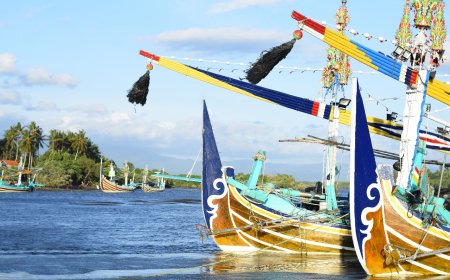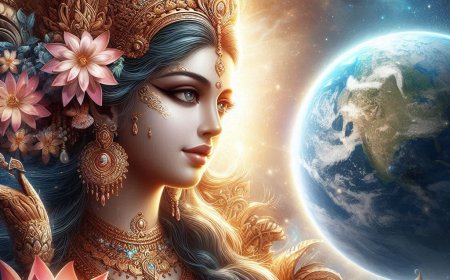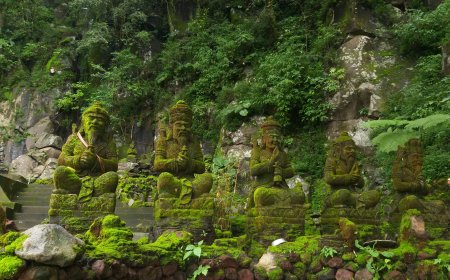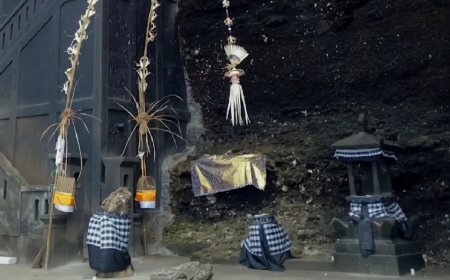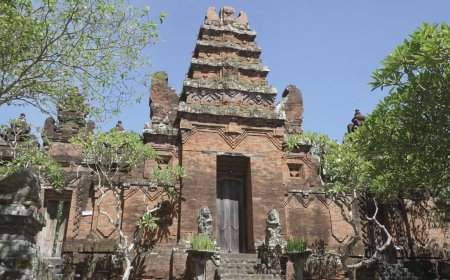Trapped in the Enchantment and Mystery of the Gambur Anglayang Temple on the Buleleng Coast
Gambur Anglayang Temple in Bali is a stunning destination, reflecting natural beauty and Hindu spirituality. Located in Gambuh village, with traditional architecture and impressive statues of deities, this temple is suitable for meditation and reflection. Apart from being a place of worship, Pura Gambur Anglayang also plays a role in Balinese culture, witnessing traditional rituals and ceremonies. It is an important symbol of Bali's Hindu heritage offering peace and spiritual understanding.
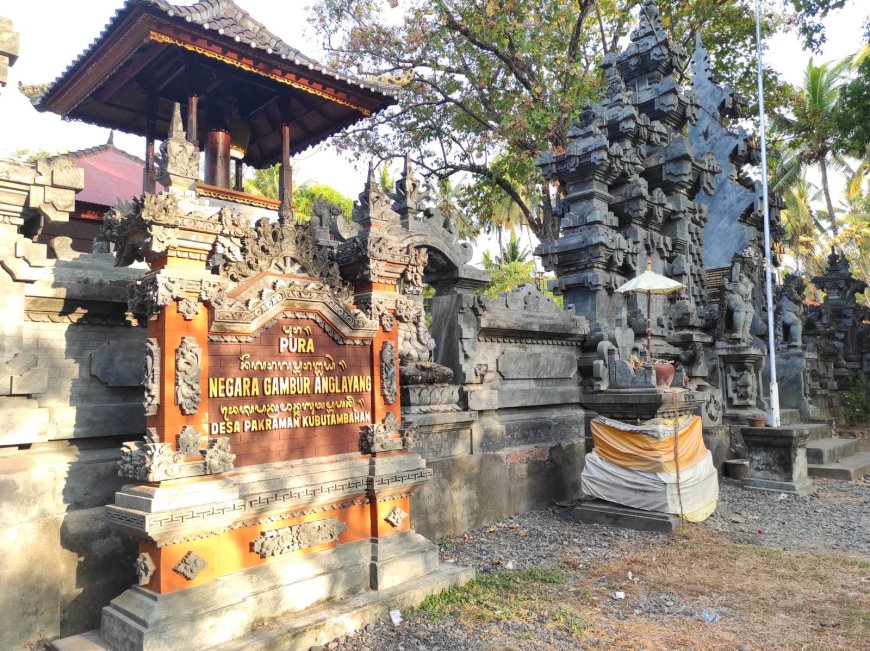
The island of Bali is one of the islands in Indonesia that has cultural diversity and is inhabited by a diverse population. The island of Bali, which covers 5,632.86 km 2 in 2011, is inhabited by a population of 3,971,257 people. In comparison, the religions in Bali are Islam (5.2%), Christians (0.8%), Buddhists (0.57%), and Hindus (93.3%). Based on the results of the 2006 population census also showed that 91.1% of the Balinese population embraced Hinduism and only 9% of non-Hindu residents. So it can be seen that Hinduism in Bali is still the majority religion adhered to by the Balinese.
The Balinese who have different religions do not come from just one ethnicity, but come from various ethnicities, such as Javanese, Bugis, Madurese, Sasak, Chinese, Arab, and others, even foreigners from outside Indonesia. This multiethnicity has been going on since the 19th century (Atmadja, 2009:1). In fact, according to Pageh (1999:12), the island of Bali has indeed been a migration destination for hundreds of years, around the 14th to 16th centuries. This is reinforced by Mudana (2004:1) who says that the Bali area is basically an open area. Bali's openness to other communities can be proven by the existence of various historical relics, both from prehistoric times and historical times.
Balinese society as such, theoretically has a great potential for conflict. Starting from all the explanations above, multicultural education really needs to be given in order to foster a sense of love for the homeland, especially in accepting differences, diversity, diversity such as ethnic, cultural and religious diversity. One that can be used as informal education is Pura Negara Gambur Anglayang. The temple which depicts multicultural characteristics is located in Kubudindingan Traditional Village, Buleleng.
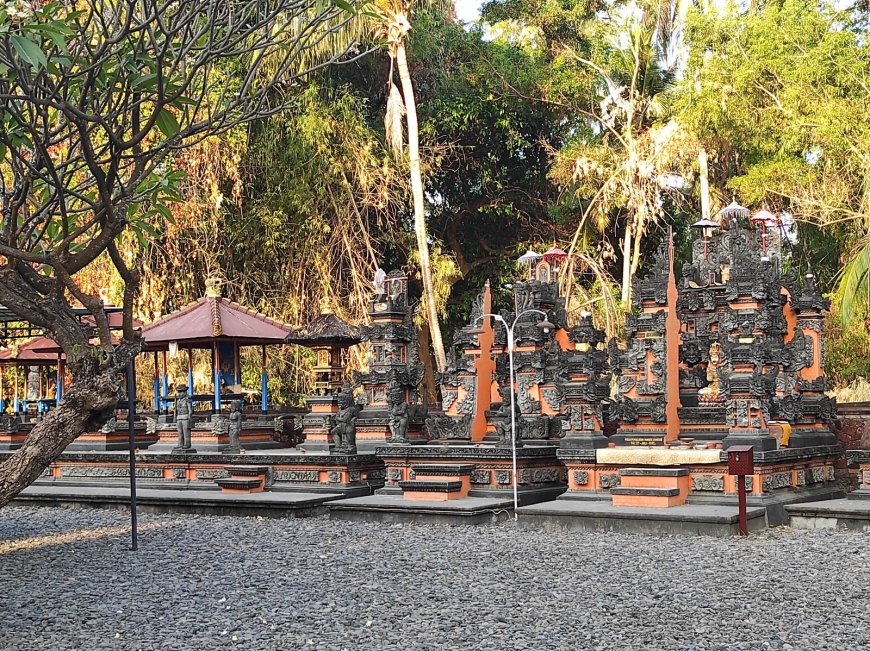 Sacred Building of Gambur Anglayang Temple (Photo Source: Editorial Collection)
Sacred Building of Gambur Anglayang Temple (Photo Source: Editorial Collection)
The interesting thing about Pura Negara Gambur Anglayang is that eight unique pelinggih were found which reflect elements of diversity in a peaceful space. The eight pelinggih are Ratu Bagus Sundawan from elements of Sundanese ethnicity, Ratu Bagus Malay pelinggih from elements of the Malay race, Ratu Ayu Syahbandar and Ratu Manik Mas which show Chinese or Buddhist elements, Ratu Pasek pelinggih, Dewi Sri and Ratu Gede Shiva which reflect Hindu elements and the most unique is the Ratu Gede Dalem Mecca pelinggih which shows elements of Islam. Later in this temple also built a Padmasana. What's unique is that if you look closely, you can see that eight shrines are standing side by side in the same area without any partitions separating each of the shrines.
The uniqueness as seen in the Gambur Anglayang State temple makes it an interesting object to be studied further through the act of writing. What is interesting to study is the historical perspective of the structure of the Gambur Anglayang State temple, where a unique building like this is usually erected in a multicultural and multi-religious society.
The temple complex or pelinggih complex located at Gambur Anglayang State Temple is very rare to find in Bali. There is still very little writing or study regarding the Gambur Anglayang State Temple. So that it gives the writer more encouragement to do further writing. All of this will try to be studied in the form of an essay entitled "Trapped in the Enchantment and Mystery of the Gambur Anglayang Temple on the Coast of Buleleng, Bali”. Gambur Anglayang State Temple is located in the Kuta Banding beach area, Kubudindingan Village, Kubudindingan District, Buleleng Regency, Bali Province.
According to Purana Bali Dwipa and Usana Bali, it is explained that in the year Saka 1103 Sri Ekajaya reigned on the island of Bali. During his reign, the people completely ignored all religious ceremonies/rituals, implicitly the system of religious sukerta in the concept of Tri Hita Karana was not carried out. After Sri Ekajaya died, he was replaced by Bhatara Guru Sri Adikunti Retana. Bali's history was in darkness from 1126-1260 Saka.
After 44 years of living in darkness and concern, an inscription dating from 1182 Saka (1950 AD) appears that mentions the name of the King, namely Bhatara Parameswara Sri Hyang Ning. It was explained in the inscription that because the village of Kawista had been abandoned for a long time by its inhabitants, the Kawista area had become a forest with large trees growing so that it became a hideout for robbers including one called Wong Bajo. Under these circumstances, in April 1260 AD, the elders of Bulian Village approached Sri Hyang Adidewadinding so that he would be willing to organize and rearrange productive land in the Kawista area (Kubutambahan).
In connection with the king's policy at that time, coastal residents were increasingly relieved in their struggle to fulfill their lives, both physically and spiritually. The disturbances began to subside, the community's living arrangements became better, agriculture was well organized through a farming system, including the Shiva shrine or shrine in Kuta Appeal which was well maintained. This simple pelinggih, namely the Shiva shrine, is right on the back of the island of Bali. The oldest called it “enjung” (cape).
In the footsteps of Pura Pasek Penegil Darma Kubu, it is additionally explained that the northern cape of the island of Bali, looking at the condition of the land, shows that in ancient times this location contained a leguna (lake located on the edge of the sea), which was the estuary of the Pangkung Dalem, Pangkung Pastu, Tukad Gunting, Tukad Merangi and Tukad Lempedu, which all ends at Kubucepatn beach. This means that all river flows from East Pangkung Dalem are accommodated by the lake on the seashore mentioned above (leguna).
In a brief book about the history of Bulian village, it is explained that in ancient times sea traders and priests carrying religious missions could enter the island of Bali via any beach, because they used small boats and canoes. Regions of North Bali (Buleleng), Sangsit (Pabean Sangsit), Kubu added and Julah (Monograph of Bulian Village. In connection with the description above, the port for Kubuaddan Village (current name) is in Kuta Appeal in Enjung Kubuaddan (Enjung is the same as Tanjung).
Thanks to the hard efforts made by King Bhatara Parameswara, the economy at that time was finally quite developed, trade relations between islands and abroad were quite smooth, including relations with Sunda, Malay, India, Mecca, China so that the Kawista area was quite prosperous. Due to the very smooth economic conditions of trade relations, one day it is said that a Bahtra (a boat) with several passengers (crew members) of various ethnicities (tribes) was docked at Kuta Appeal beach. The purpose of the trading boat (Bahtra) was to look for trading materials as well as looking for food, water and the like. The ship/boat crew consists of various ethnic groups, including Chinese, Malay, Sundanese, and some of them are Muslim. After getting the necessities (merchandise and consumption materials), the ship's crew got ready to continue their journey to their destination, but a disaster suddenly occurred and the boat (ark) had a leak so they couldn't leave. Then the crew, assisted by local residents, tried to repair the leaking ship
As a result of this, the local residents invited the crew of the ship (boat) and the ship's entourage to pray together at the shrine (parahyangan) on the coast of Kuta Appeal to ask for strength, help and ask for permission. If their journey is safe and their business or career is successful, they vow or are willing to acknowledge, believe and believe and participate in glorifying and maintaining a sacred place to worship the greatness of Shang Hyang Widhi with Prabawa (manifestation) as Shiva.
While the ship was docked at the Kuta Appeal port and while the ship was repairing leaks, the crew also had time to communicate for a relatively long time with the residents of Kuta Appeal, fishermen, farmers and traders. They fill each other in, exchange experiences or coastal residents absorb more knowledge from the ship's crew.
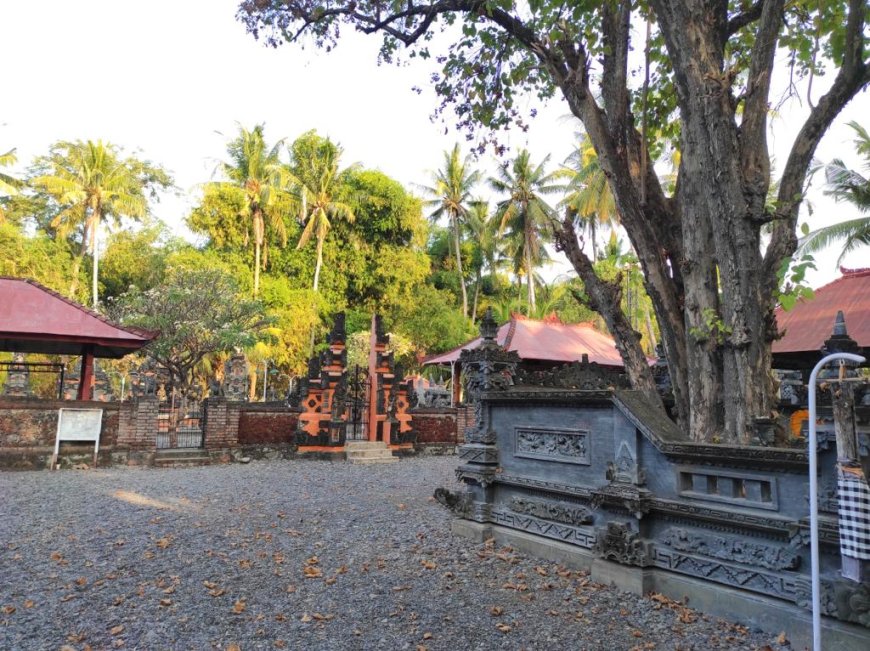 Middle page/madya mandala of Gambur Anglayang Temple (Photo Source: Editor's Collection)
Middle page/madya mandala of Gambur Anglayang Temple (Photo Source: Editor's Collection)
Based on all of this, as a form of gratitude for all good services in the form of trade knowledge, knowledge of farming, fishing, including knowledge of soldiering, then based on moral commitment, a memorial monument (consecrated miniature) in the form of simple shrines was built. This pelinggih is equipped with an embodiment in accordance with the imagination of the people in accordance with its undagiundagi besides the main pelinggih, namely Lord Shiva.
With the description above, a sacred building (pura) was created with various forms of shrines and names with various ethnicities. for example Bhatara Ratu Gede Siwa Rambut Sedana (linggih tree), Bhatara Sri Dwijendra Ratu Agung Dalem Mekah (Islam), Ratu Agung Syahbandar (China) is the god of Customs (harbor), Ratu Agung Melayu (Malay ethnicity), and Ratu Bagus Nganten (Ratu Bagus Sundawan) from the Sundanese ethnicity of West Java.
In connection with the above, a temple was created which was originally named Pura Pula Gara and became Pura Kerta Negara Loka or Pura Negara Gambur Anglayang which is estimated to have been built in the 13th century AD, while the forerunner of this temple has existed since the 11th century, because the village Bulian or Banyubuah, whose territory consists of Bulian, Kubucepatn, West Sanih, is estimated to have been formed or established 10 centuries ago as a defensive fort and place of asceticism.
Pura Negara Gambur Anglayang is divided into three pages, namely jabaan or nista mandala as a symbol of bhur loka, middle jaba or madya mandala as a symbol of bwah loka, jeroan or main mandala as a symbol of swah loka. The deeper you go (above) the purer the temple grounds become. Between the innards and the middle jaba is separated by the temple brackets or kori Agung. Before arriving at the inner courtyard (jeroan) via the kori Agung, you must first enter the temple of Bentar, namely the first entrance from the outer courtyard (jabaan or jaba pisan) to the middle courtyard (jaba middle)
The outer courtyard/nista mandala of Pura Negara Gambur Anglayang consists of Pelinggih Ratu Ayu Taman, Sumur Tirtha, Pelinggih Ratu Gede Mas Punggawa, Bale Kulkul, Candi Bentar. The middle/madya mandala courtyard of the Gambur Anglayang State Temple consists of Bale Pebat, Bale Kulkul. And the main page/mandala of the Gambur Anglayang State Temple consists of Bale
Pura Negara Gambur Anglayang was founded in 1260 or the 13th century by residents around Kuta Appeal beach during the reign of King Bhatara Parameswara. The structure of Pura Negara Gambur Anglayang consists of three courtyards or mandalas, namely Nista Mandala (side jaba), madya mandala (middle jaba), and main mandala (innards). Vertically, the pelinggih at Pura Negara Gambur Anglayang refers to the Triangga concept which consists of (legs, body and head).









